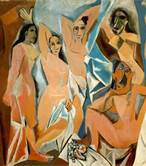 In 2007, Newsweek named a 1907 painting by Pablo Picasso that came to be known as Les Demoiselles d’Avignon (shown left) as the most important painting in the previous 100 years. But when the then modestly successful Picasso first showed the piece to a small group of artists, dealers and friends, things did not go well. Note how Newsweek described it.
In 2007, Newsweek named a 1907 painting by Pablo Picasso that came to be known as Les Demoiselles d’Avignon (shown left) as the most important painting in the previous 100 years. But when the then modestly successful Picasso first showed the piece to a small group of artists, dealers and friends, things did not go well. Note how Newsweek described it.
When Matisse saw Picasso’s just-completed, eight-foot-square painting “Les Demoiselles d’Avignon” in the Spaniard’s studio in a ramshackle Paris building nicknamed “The Laundry Boat,” he was shocked at how raw, cacophonic and nasty it looked. Another modernist, André Derain, figured that Picasso had gone so far off the deep end that he’d soon commit suicide. Even Picasso’s loyal patron Gertrude Stein deemed the picture a “veritable cataclysm.” And you know what? It’s still pretty ugly.
Les Demoiselles surely was revolutionary and controversial, and it indeed created wide anger and disagreement even amongst his closest associates and friends. In one sense at least, that should not be surprising in that the work was everything that art at the time was not supposed to be (like ugly, disconcerting and different). As Medium points out, “[i]t flouted laws of perspective, representation and beauty that had endured for over four hundred years.” The painting was not exhibited until 1916 and not widely recognized as a revolutionary achievement until the early 1920s. Yet the work became seminal in the early development of both Cubism and of modern art generally. It is now indisputably a masterpiece.
After such a revolutionary event, we tend to see it as having been inevitable. Such is the narrative fallacy. In a recent paper, ESSEC Business School’s Stoyan Sgourev notes that scholars of innovation typically focus upon the usual type of case, where incremental improvements rule the day. Sgourev moves past the typical to look at the unusual type of case, where there is a radical leap forward (equivalent to Thomas Kuhn’s paradigm shifts in science), as with Picasso and Les Demoiselles.
As Sgourev carefully argues, the Paris art market of Picasso’s time had recently become receptive to the commercial possibilities of risk-taking. Thus artistic innovation was becoming commercially viable. Breaking with the past was then being encouraged for the first time. It would soon be demanded. Most significantly for our purposes, Sgourev’s analysis of Cubism suggests that having an exceptional idea isn’t enough. For radical innovation really to take hold, market conditions have to be right, making its success matters of luck and timing as much as of genius.
As I have noted before, the outcomes in many activities of life involve elements of both skill and luck. Investing is one of these. So is commercial artistic success (note that Van Gogh — no less a genius than Picasso — never sold a painting in his lifetime).
We all like to think that our successes are earned and that only our failures are due to luck – bad luck. But the old expression – it’s better to be lucky than good – is at least partly true. That said, it’s best to be lucky and good. As a consequence, in all probabilistic fields (such as investing), the best performers dwell on process and diversify their bets. You should do the same.

Thanks for your input in NYC! PS, do you get paid to put a Chevy ad in your blog? I may have to start blogging.
You’re welcome. And no, I don’t get paid for the WordPress ads or even see them. Thanks for asking.